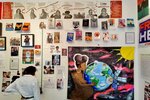Since being released from prison more than two decades ago, the Rev. Michelle Simmons has turned her formidable energies into helping others.
This item is available in full to subscribers.
You can also purchase this individual item for $1.50
We have recently launched a new and improved website. To continue reading, you will need to either log into your subscriber account, or purchase a new subscription.
If you are a digital subscriber with an active subscription, then you already have an account here. Just reset your password if you've not yet logged in to your account on this new site.
If you are a current print subscriber, you can set up a free website account by clicking here.
Otherwise, click here to view your options for subscribing.
Please log in to continue |


Since being released from prison more than two decades ago for crimes related to drug addiction, the Rev. Michelle Simmons has turned her formidable energies into helping other formerly incarcerated women transition back into society.
She founded Why Not Prosper, a nonprofit based in a rowhouse on Germantown’s East Chelten Avenue. Since 2001, the organization has offered support and services to about 1,700 people.
Now, art and artifacts from those women are on permanent display in a converted storage building behind the nonprofit’s headquarters, christened last Friday as the Formerly Incarcerated Renaissance Museum (F.I.R.M.).
“I’m tired of people telling us about our stories and trying to write it and share it. We could tell our own stories pretty well,” Simmons said. “We’re super amazing. We work so hard. We’re so powerful, and we’re not our mistakes.”
Some objects on display were used or made by people while incarcerated, as the wall text says, to “help individuals retain their identity.” Among them are a pair of prison-issue shorts that Joyce “Starr” Granger wore for 35 years in the Pennsylvania Department of Corrections; a crocheted purple heart and handmade card that Jamila Harris was surprised with by fellow inmates on her 34th birthday and black khimar headscarf worn by Rasheeda Hyland while incarcerated.
“It was the one piece of my identity that couldn’t be stripped from me,” Hyland wrote.
The collection of materials — hung in a dense salon-style floor-to-ceiling on the museum walls — also features artwork and poetry made by people while incarcerated, and documentation for people who were pardoned and released.
“We’ve got a drill in there. You wouldn’t think that’s nothing but a drill, but that was the thing that changed that man’s life,” Simmons said. “Him being able to learn a craft and now he has a contracting company.”
On display are lots of books. The walls are lined with fiction and nonfiction paperbacks — some creased and dog-eared — written by both incarcerated and formerly incarcerated authors, including Simmons.
“I wanted to write down what was important to me because I made it through. I ain’t die in the midst of it,” she said. “I wanted somebody to know this hope. Keep going. The name of my book is ‘Keep it moving.’”
Simmons made the opening day of the new museum into a community event with food, a DJ, local vendors and speeches. She was joined by criminal justice luminaries, such as the formerly incarcerated podcaster David Luis “Suave” Gonzalez, who won the Pulitzer Prize in 2022 for his series “Suave.”
When Simmons cut the blue ribbon across the museum door, she was helped by Andrea James, the founder of the National Council for Incarcerated and Formerly Incarcerated Women and Girls, who supported Simmons with funds to build the museum.
Holding a giant pair of scissors at the threshold, Simmons let herself weep.
“I started crying when we was cutting the ribbon because it is emotional,” she said. “From a crackhead little girl running around barefooted, Black, nappy head, to being the visionary and holding true to what God told me to do, was really emotional for me.
“That moment when I seen all my sisters around me, it kind of broke me down,” she said.
The Formerly Incarcerated Renaissance Museum is open for visitors from 10 a.m. to 2 p.m. Mondays through Thursdays. If it proves to be successful, Simmon said she may expand into the neighboring lot.